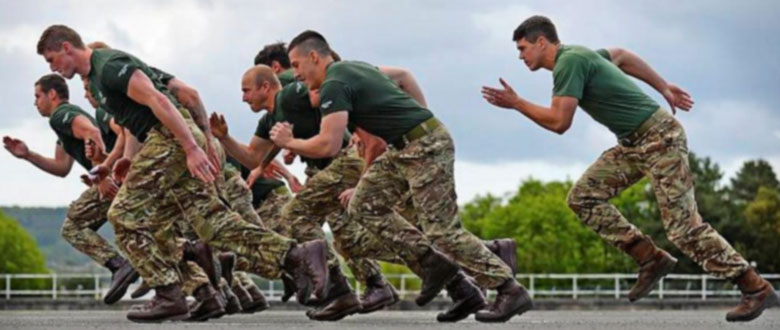A summer of sporting endeavour – as the World Cup and Wimbledon are well underway – we are provided with plenty of opportunities to marvel at just how fit elite sports people are, generally from the comfort of a sofa. Even if you put in a few hours per week at the gym, or regularly go jogging, it’s hard not to see the gulf which exists between professional athletes and us mere mortals. The question is whether these highly toned gods and goddesses represent the absolute zenith of fitness, or whether there’s a higher level yet. One possible way of answering this is to take a look at the fitness requirements demanded of anyone who wants to join the Royal Marines.
Bear in mind that these are the minimum standards expected before the Marines get their hands on you and start actually training you. This, in other words, is the easy bit.
Pre-Joining Fitness Test (PJFT)
That’s right, a test to see if you’re up to the challenge of taking the proper test. First you have to run 2.4km on a treadmill set at a 2% incline, and you have to run it in less than 12 and a half minutes. Then you get to rest for a whole minute, after which you have to do the run again, this time in less than 10 minutes. Manage this and you’re considered ready for the Potential Royal Marines Course (PRMC)
PRMC
This intensive four day course is a combination of mental and physical tests, but it’s the latter we’re concentrating on here. Day Two is when the fun really starts. After completing an outdoor group version of the PJFT you’ll be scored on a variety of gym tests. These include the dreaded ‘bleep test’, where failing to reach at least level 11 means your training comes to a premature end. Then you find out how many press ups you can do in 2 minutes, with 60 being required for maximum points, and how many sit ups you can do in two minutes (neither of these will feel like two minutes) – the answer being 85, if you want to score maximum points. The last gym test consists of pull ups on a wooden beam. Manage less than three and you automatically fail. Score 16 and you get maximum points, and all candidates are expected to carry on until they reach their physical limit.
Outside the Gym
If, after all that, you’re thinking a nice lie down might be in order then perhaps you’re not cut out for the Marines after all. What actually happens next is a swimming test which consists of:
- Jumping from a three metre platform
- Swimming two 100m lengths of breaststroke
- Diving for a rubber brick at the bottom of the deep end
The Next Day
The next day is when you realise the day before was actually the Royal Marines idea of a gentle introduction. It begins with the Tarzan Assault Course, which tests your physical ability to get around obstacles at the same time as your mental capacity to do so whilst balancing on a rope 30ft up in the air. The assault course which follows is designed to test your physical strength, mental determination and ability to follow instructions and therefore avoid injuring yourself. Get through this in one piece and your reward is the endurance test. It lasts for 90 minutes, covers 2.5 miles and involves plenty of crawling through underwater tunnels. For a mile of the course you’ll be expected to keep pace a with course instructor, and by the time you finish the final four cross-country miles, you’ll be wet, cold and exhausted.
What this is all designed to do is make sure that you’ve got what it takes to handle the actual Marines Commando training, which culminates with challenges such as a nine mile speed march, our old friend the Tarzan Assault Course – but this time in full kit and against the clock – and a 30 mile march across the forbiddingly barren landscape of Dartmoor.
Compare this to the training regimes of some top athletes. Mo Farah runs an average of 135 miles per week, Cristiano Ronaldo was reputed at one time to do as many as 3,000 sit-ups every day and even the legendarily laidback Usain Bolt has been filmed training so hard that he eventually throws up next to the running track. Perhaps the biggest difference lies in the fact that Royal Marines are being chosen and trained to be able to deliver in physical and mental terms, in the most hostile environments imaginable.



